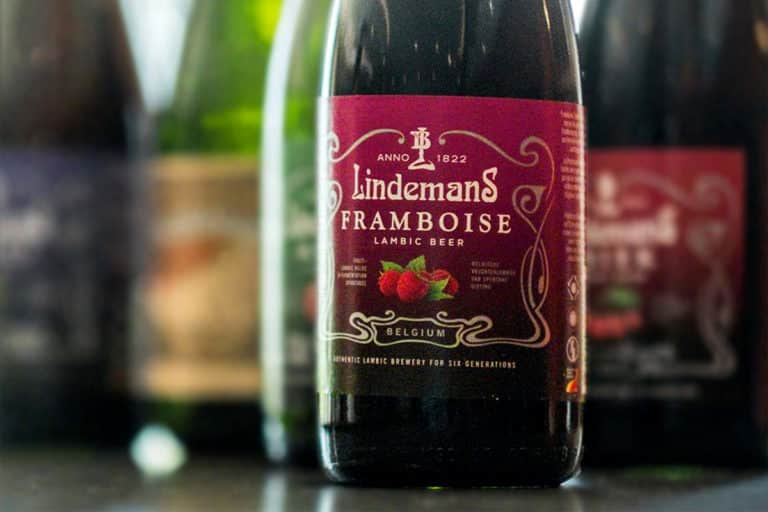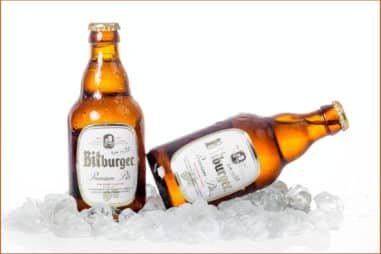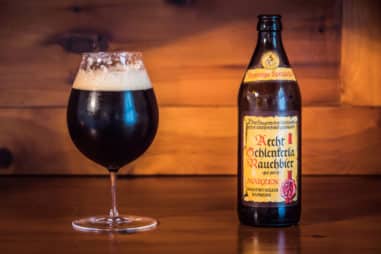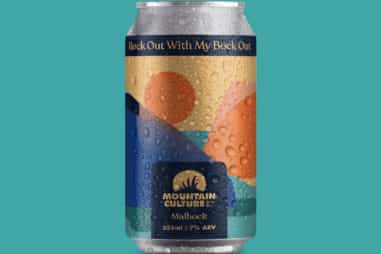Lambic is one of those beers that takes many years to craft. If you have a passion for brewing, it is well worth the wait. And so, to be able to fill your Lambic Beer need, this guide will help you get up to speed.
What Makes a Beer a Lambic?
If your beer has a dryness to it, if you get a feeling of cider with an in-your-face sourness, that is most likely Lambic.
The real deal definition comes from the time invested into making a Lambic. It takes years of patience and dedication. And most of all, harnessing the power of natural microbes to do the work.
Where Do Lambic Beers Come From?
Imagine a place in a valley, surrounded by two rivers. That view is how the Pajottenland region’s locals got inspired to make Lambic. Of course, don’t forget about Brussels.
Pajottenland and Brussels are both locations in Belgium. But Pajottenland is more iconic because it is close to the rivers Senne and Dendre.
What Does Lambic Mean in English?
Not all beer names have fully defined origins nor translatable names. Lambic is one of those old beers that have a lot of unknowns about it.
Some speculate that Lambic stands for the town “Lembeek” near Brussels. Some old languages translate the suffix as “stream” or “brook.” Some go as far as relating it to the mashing vessel “alembic.” Whatever the case may be, it might forever be steeped in mystery.
How to Pronounce Lambic
French and Dutch speakers have distinctions like “Lam-Buhk” and “Lahm-Beek.” For French folk, they have a shorter “bic” part compared to the Dutch. The Dutch seem to put more emphasis on the “i” in Lambic.
Is Lambic Beer or Wine?
Lambic is not a wine per se. It looks like a wine from an outsider’s perspective. It uses the same bottles like champagne and wines. It ferments around the same duration as wines do.
Wines are fundamentally made from fermented grape juice. On the other hand, Lambics are made from a combination of grains.
What Kind of Beer Is Lambic?
Lambics welcome you to the world of Sour Wheat Beers. It combines both worlds into a visually appealing and great tasting explosion.
Lambic beers are not characteristically bitter and hoppy. They are beers that showcase the multi-faceted craft that is brewing beer.
Is Lambic a Craft Beer?
Lambics meet the definition of Craft Beers. Lambics are hard to make, which is why their production has waned.
If you are an independent and small brewer, you are a brewer of Craft Beer. If you want specific numbers, a yearly output of fewer than 6 million barrels of beer fills the bill.
Is a Lambic an Ale or a Lager?
Ale is a category that Lambics loosely fall into. Ale microbes are fermented in warmer temperatures relative to Lagers. The same is true for Lambics.
Lambic beers do not use brewer’s yeast. It is one of the things that you can argue against Lambics’ true-blue ale classification.
Is a Lambic a Wild Ale?
If you attach the label “wild” to Lambics, you are spot on. Wild microorganisms in the air work their magic instead, or in concert, with your basic brewer’s yeast.
You could say that this beer lets itself develop within mother nature’s loving embrace.
Is a Lambic a Sour Beer?
Tartness makes the Lambic. If your Lambic is not sour, it is probably not the beer you are looking for. Moreover, this beer matches the profile of sour beers. Sour beers employ Lacto-fermenting elements in their wort: it is the secret sauce if you will.
What Makes a Lambic Sour?
Shower your Lambic with a soup of lactic acid-producing bacteria and specific yeasts. Little fellows like Lactobacillus, Brettanomyces, and Saccharomyces will give you the mouth-puckering you desire.
Are All Lambic Beers Sour?
The base unblended Lambic has a notable acidic taste element to it. However, other variants have blends that balance the sourness with sweetness.
Lambic is like a club, it has got a lot of members. The members may share the same “sour” goals, but they can achieve them in their own special way.
Is Lambic a Saison?
Saison is a style of Belgian Ale, a sibling to Lambic if you will. You could differentiate the two by taking a closer look at their fermenting agents. In particular, Saisons introduce specific yeasts in their ferments.
Moreover, Saisons have added seasonings like honey, herbs, and spices. Whereas Lambics, in their base form, are virgins in that regard.
Is Lambic a Wheat Beer?
Belgian brewers seem to love crafting wheat beers. Lambics are no exception. The fundamental grains in the recipe of this beer always contain at least 35 to 50% wheat. If you fail to meet the criteria, you are not dealing with a Lambic, strictly speaking.
You could use other ingredients, but don’t go calling it a Lambic. Traditional Belgian brewers and hardcore fans won’t take too kindly to non-conformance.
Is Lambic Beer Gluten-free?
Unfortunately, wheat and Gluten go hand in hand. You can try Lambic styles without the wheat. The alternative grains used would be sorghum and corn.
It’s a sad thing that not everyone can enjoy the original. Simulated styles are simply simulations.
Is Lambic Beer a Cider?
Some individuals consider Lambics to have a striking similarity to Ciders in taste. Lambics emit fruitiness but not because of adding fruit. Rather, it is the result of the interaction of yeast and grain.
For Ciders, the fruit juice is fermented into an alcoholic beverage. It is close to Lambic, but no cigar.
Lambic vs. Gose
If you think Gose is better than Lambic, think again. You need to compare beers apple to apple. Here is why:
| Details | Gose | Lambic |
| Country of Origin | Germany | Belgium |
| Added Spices | Coriander and Salt | No Added Spices |
| Time of Fermentation | Several Weeks | At least 12 Weeks |
| Fermenting Agent | Specific Cultured Yeast and Bacteria are Pitched | Wild Yeast and Bacteria
Naturally Introduced |
Lambic vs. Flanders Red Ale
Lambic and Flanders Red Ale are pretty much neck and neck when it comes to sour power. However, Flanders Red Ale boasts up to 20% maize in the grain bill. It is also considered by many as the most wine-like of all the beers. Tough luck for Lambic in that regard.
What Does Lambic Beer Taste Like?
With Lambic Beer, you get to taste a cidery and tart liquor that may finish dry. It has the funkiness of a ferment, with fruit tones courtesy of the Brettanomyces. It has a lactic sourness that screams at the uninitiated. Don’t look for it being hoppy because hops are just wallflowers in this party.
Are Lambic Beers Sweet?
The original unblended Lambic is far from a sweet drink that would please sugar junkies. But don’t you lose hope. Lambic has sweet options that are well worth your while.
Enter the colorful world of Fruit Lambics.
What Is a Fruit Lambic Beer?
After the long process of aging your Lambic, you can add your favorite whole fruit or puree into the mix. You can pick and choose from a wide selection: Cassis, Framboise, Kriek, or Peche. Each of these names represents different fruit commonly incorporated.
What Is Raspberry Lambic?
Framboise Lambic is a Raspberry Lambic. It is a French term for raspberry. Framboise is a fruit beer enhanced by the juice of raspberries. You can also savor its intense raspberry fragrance.
Are Lambics Good for You?
As long as the bacteria and yeasts that remain alive are the kinds that aid in digestion, Yes. The maintenance of your gut biome is an important part of a healthy digestive system. On the other hand, a fully pasteurized Lambic would defeat the benefits.
Is Lambic Beer Healthy?
You can aid your digestion by reinforcing your gut’s workforce with the bacteria in Lambic. These bacteria help release the locked nutrients from within your food. They also push back nasty bugs.
Of course, maintaining a balance with alcohol intake is crucial. Going ham on the beer affects other aspects of your health.
Is Lambic a Probiotic?
Live bacteria and yeasts that are good for you are part of the Lambic makeup. Some are pasteurized, while others are more persistent.
Make sure you don’t overdo your drinking though. No number of probiotics are going to save you from a beer belly.
Is Lambic Beer Alcoholic?
Lambic alcohol levels play around two to eight percent. You can get the alcohol level that is right for you. There is even one brew that alleges an experimental Alcohol By Volume (ABV) of 9.1%.
How Strong Is Lambic Beer?
Your run-of-the-mill beers are in the range of four to seven percent ABV. Lambic beers can skirt at the upper boundary of the said span.
Beer “strength” feels somewhat relative. Not all US states agree on the ABV border before entering strong liquor land. Some states specify 3.2%, others are 4.0%. On that note, Lambic is “strong” on paper, but you should be the judge of that.
Is Lambic Carbonated?
When it comes to carbonation, it’s a Yes and a No. The traditional unblended brew of Lambic beer is served uncarbonated. Nevertheless, some versions of Lambic become sparkling by bottle conditioning. It all depends on the end results desired by the brewer.
If you think about it, imagine working for several years straight. The microbes are dead tired from all that work.
How Much Sugar Is in a Lambic?
The classic unblended Lambic has no added sugar. Considering all forms of Lambic, a 12oz (330ml) Fruited Lambic would have 16 to 22 grams of sugar.
Note that the microorganisms added were to make sure they ate the sugars so you would get your alcohol. Any remainder sugar means the aging was incomplete in some way.
You can deliberately add priming sugar for the carbonation step if that is your goal. Concerning Lambic subclasses, Fruited Lambics enjoy sugars from the fruits.
How to Serve and Drink Lambic Beer
Being a Lambic bartender is tough so here is a framework you can follow:
- Chill your Lambic to 40 to 55°F (4 to 12°C).
- Set it on the counter before pouring. Let it warm up a bit to release the volatile organics for improved aroma and flavor.
- Take out your glassware. A tulip, snifter, or stange works well with Lambics. If you don’t have one, the classic wine glass will do the job.
- If you want a clear beer, don’t roll your beer.
- Pour into your glass slowly. The speed is dependent on how carbonated your beer is. You wouldn’t want a foamy mess now, would you?
- Hold your glass at an angle of around horizontal to 45°. Again, it will depend on the carbonation.
- Upon reaching 1/4th to ½ of your glass, slowly tilt the glass vertically to improve foam formation.
- If you want to get all the lovely flavor from the yeast, don’t pour until the bottom of the bottle.
- Loosen the yeast with a circular motion.
- Finish your pour. Enjoy.
Should Lambic Beer Be Refrigerated?
Ambient temperatures of 80°F (27°C) are a deal-breaker for any kind of beer. The ideal storage temperature is 55 to 60° (12 to 16°C) which is easily achievable by your fridge. If you have a colder climate and you can maintain a constant temperature on a wooden rack, it should not be a problem.
What Temperature Should Lambic Beer Be Served at?
The magic numbers you should target are 40 to 55°F (4 to 12°C). If your beer is underwhelming, a warmer temperature would be like 45 to 50°F (7 to 10°C).
Do You Drink Lambic Beer Cold?
If you have already experienced some Lambic brands and find it too sour or cloyingly sweet, cool it down. The chill numbs your taste. Experiment with the cold to discover the right levels for you.
If you want to intensify the tastes and smells, serve it at relatively warm temperatures. Again, only you can be the judge.
What Goes With Lambic Beer?
The formula with Lambic is fruitiness so food that works well with fruit is the jackpot. Try it on salads with fresh cheeses: mascarpone, cottage, feta, to name a few.
How does fruit-glazed meat sound to you? A big bowl of cassoulet? You can even have it with your Belgian waffles.
How Are Lambics Made?
Below is the outline for creating unblended Lambic according to tradition:
- Prepare your grist of Pale or Pilsner-style malted barley, and raw, unmalted wheat.
- Do a turbid mash
- Sparge your mash.
- Boil your mash for three to four hours.
- Add in your aged hops.
- Cool at least 50% of the wort. If you have any rectangular pans, try using them.
- Cool for 8 to 16 hours.
- Transfer the wort to your fermentation vessels.
- Leave the product to age.
- You may add natural sugars to prime the re-fermentation process once bottled.
How Do You Make Lambic Beer at Home?
Homebrewing something as complicated as Lambic is easier with the “extract” option. Here is the outline:
- Secure your dry or liquid extracts of malt. Select extracts intended for wheat beer or long fermentation periods.
- Bring your wort to a boil.
- Pop in your aged hops at the start of the boil.
- Boil your wort for an hour. You can push it to two hours dependent on the initial gallonage.
- Cool your hops in a rectangular pan and leave for 8 to 16 hours. If you don’t like the idea of an open pan, you can go for a covered kettle.
- Pitch your starter culture after cooling.
- Transfer to your oak vessel or glass fermentation vessel with oak wood inserts.
- Leave your brew to age for the desired duration.
- Bottle your brew and add priming sugar for the desired effervescence.
- Add in your whole fruit or puree preference if desired.
How Long Does It Take to Brew a Lambic Beer?
Even with extract brewing, it takes Lambic beer around two hours to complete the boiling step. You will only save one hour from the traditional turbid mashing. At least you don’t have to put your back into painfully grinding raw wheat.
Does Lambic Beer Have Hops?
Aged hops are the preferred hops additive for Lambics. The type really does not matter. You will only need the hops for their preservative quality, and less for their flavor.
Aged hops work well for the long journey of the aging process. It dampens any sharp multiplication of bugs for an extended period.
How Do You Ferment a Lambic Beer?
Ferment your Lambic in oak barrels. You can buy oak barrels in small sizes up to five liters. If you have glass vessels, go for it. You can add that oaken touch by slipping in some oak chips or staves.
Check your ferment every month for the integrity of the seals. The first month usually is marked by pellicle formation. You will see a film of growth that would make a greenhorn fermenter worry about having messed up.
After six months to a year, check to see if the pellicle had sunk. If it did, you are stepping closer to the finish line. A few more years of patiently checking should yield some fine product. Ideally, you would have several batches in a row so you could sample them every year to find the best year.
What Is the Starter Culture That Is Added to the Wort to Produce a Lambic?
Brace yourself for the scientific names Saccharomyces and Brettanomyces and Pediococcus and Lactobacillus. You can also swap Brettanomyces with Saccharomyces but leave that to the experts.
You can add them to your wort in one go, or add them in stages like the natural scheme of things. Regardless, if you are just beginning, make your process simple and just dump it all in.
Does Lambic Beer Contain Yeast?
Saccharomyces and Brettanomyces are the yeast you will be needing in your ferment. Some strains work well with Lambic so consult your neighborhood expert. And don’t be afraid to ask your vendors as well.
Can You Age a Lambic?
Brettanomyces work their alchemy in the long process of aging a Lambic. These yeasts work slowly compared to brewer’s yeast. Because of this, there is no way around the aging process. Otherwise, you cannot get the characteristic flavor of Lambics.
How Long Can You Age Lambics?
The aging process takes a traditional standard of one or two or three years. It is not unlikely that you would find 15 to 30 years aged Lambics.
Some folks are planning to blow up the age barrier by aging Lambic in bomb shelters from World War II.
Do Lambics Age Well?
Thanks to microbial action, Lambics age well. Natural fermentation methods have been around long before the age of refrigeration. That’s why you can enjoy your favorite fermented food and drinks like cheeses and wines.
How to Store Lambic Beer
Lambics share traits with wines when stored. Storing it on its side is quite common to ensure that the cork remains moist for the perfect seal. One of the cons of this is the potential for cork flavors to develop. But it depends on cork quality.
Some brewers follow upright storage. It has its cons like lesser air contact with the microbes during aging and conditioning.
Regardless, always follow the recommendations of the specific brewer for your beer. Don’t be married to one method. The brewer knows best in this space.
What Temperature Should Lambic Be Stored at?
Lambic loves a dark area with somewhat dehumidified cool air at 50 to 65°F (10 to 19°C). Moisture should be just enough to maintain the corks’ elasticity.
Also, you should take into consideration constancy in terms of movement and temperature. Swings of these properties can affect the state of the workers inside the bottle.
How Long Are Lambics Good for?
One to two years are the normal instruction of brewers printed on their bottles. The Lambics were aged well before they even reached your home so it’s just a matter of your consumption.
They actually can last much longer because they were designed to be that way. However, the flavor might not be there anymore especially for Fruit Lambics.
How Long Does Lambic Beer Last Unopened?
Two years is the recommended best-before duration. Watch out for unpasteurized beers. They have the potential for overpopulation if you push the prescribed date. Who knows what the microorganisms cooked up.
Make sure you store your beer properly. Keep it nice and cool and dark, just the way the microbes like it.
How Long Does Lambic Beer Last After Opening?
Anecdotal evidence suggests that a week after opening the bottle is pushing it. Opening your Lambic and not finishing is like reheated food, it gets bland. Fresh is better.
Does Lambic Beer Expire and Go Bad?
A properly brewed Lambic that is stored under good practices will keep indefinitely. But, unpasteurized beer will expire as nothing will limit microbial growth. Too much of a good thing is bad.
Taste and quality can change as time passes. The longer you wait, the more chance the beer will not fit the description on the bottle.
Where to Buy Lambic Beer
The go-to places for Lambic beer in the US are Amazon and Walmart. You can mostly avail of the Fruit Lambics like Framboise as they are quite popular. Other than this, you would do well to pack your bags and take a trip to Belgium for some of the traditional liquor. Brussels is known to give Beer Tours so you should try that.
Why Are Lambics So Expensive?
Making Lambics take more time and effort than your usual beer. And the more time and effort it takes, the costlier it is to craft.
Imagine having to stockpile your beer for years before they are ready to go. And the fact that the needed microflora lives around Belgium doesn’t help with the cost either.







